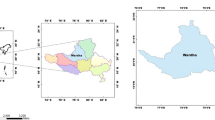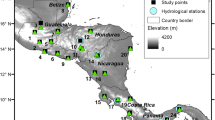Abstract
The objective of this paper is to present how the Coupled Model Inter-comparison Project phase 3 (CMIP3) multi-model datasets might be used to calculate drought indices for Saudi Arabia. Widely used drought indices such as the Standardized Precipitation Index (SPI) and the Palmer Drought Severity Index (PDSI) are constructed and analyzed using observed rainfall from 27 stations as well as data from best performing CMIP3 models along with other variables for the present climate. Of the 22 CMIP3 models, the Canadian (CC: CCCMA-CGCM3.1) and the Australian (CS: CSIRO-Mk3.0) models were used in estimating the annual rainfall over Saudi Arabia while the German/Korean (MI: MIUB-ECHO-G) and the Japanese (MM: MIROC3.2 and MR: MRI-CGCM2.3.2) models were used in estimating the annual temperature. Results show that the CS model is superior to the other 21 CMIP3 models in calculating both SPI and PDSI. As for drought indices, PDSI (76% and 65% for CS and CC, respectively) performs well in assessing the spatial distribution of drought conditions as well as in determining the number of events (63% and 26% for CS and CC, respectively) within the different drought categories when compared to observations. Therefore, further use of PDSI is recommended for drought diagnosis in future climate for the disaster management purposes for Saudi Arabia, however, the use of the latest climate models datasets e.g. AR5 or AR6 may need further investigation.







Similar content being viewed by others
References
Abramowitz M, Stegun IA (1965) Handbook of mathematical functions. Dover Publications, New York
Almazroui M, Islam MN, Athar H, Jones PD, Rahman MA (2012a) Recent climate change in the Arabian Peninsula: annual rainfall and temperature analysis of Saudi Arabia for 1978–2009. Int J Climatol 32:953–966. https://doi.org/10.1002/joc.3446
Almazroui M, Islam MN, Jones PD, Athar H, Rahman MA (2012b) Recent climate change in the Arabian Peninsula: seasonal rainfall and temperature climatology of Saudi Arabia for 1979–2009. Atmos Res 111:29–45. https://doi.org/10.1016/j.atmosres.2012.02.013
Almazroui M, Saeed S, Islam MN, Khalid MS, Alkhalaf AK, Dambul R (2017a) Assessment of uncertainties in projected temperature and precipitation over the Arabian Peninsula: a comparison between different categories of CMIP3 models. Earth Syst Environ. https://doi.org/10.1007/s41748-017-0012-z
Almazroui M, Tayeb O et al (2017b) Saudi-KAU coupled global climate model: description and performance. Earth Syst Environ. https://doi.org/10.1007/s41748-017-0009-7
Bhalme HN, Mooley AD (1980) Large-scale droughts/floods and monsoon circulation. Mon Weather Rev 108:1197–1211
Blenkinsop S, Fowler HJ (2007) Changes in European drought characteristics projected by the PRUDENCE regional climate models. Int J Climatol 27:1595–1610. https://doi.org/10.1002/joc.1538
Busby SJ, Briffa KR, Osborn TJ (2007) Simulation of ENSO forcings on US drought by the HadCM3 coupled climate model. J Geophy Res. https://doi.org/10.1029/2007jd008705
Collins WD, Bitz CM, Blackmon ML, Bonan GB, Bretherton CS, Carton JA, Chang P, Doney SC, Hack JJ, Henderson TB, Kiehl JT, Large WG, McKenna DS, Santer BD, Smith RD (2006) The community climate system model version 3 (CCSM3). J Clim 19:2122–2143
Cook KH, Vizy EK (2006) Coupled model simulations of the West African Monsoon system: twentieth- and twenty-first-century simulations. J Clim 19:3681–3703. https://doi.org/10.1175/JCLI3814.1
Delworth TL, Broccoli AJ, Rosati A, Stouffer RJ, Balaji V, Beesley JA, Cooke WF, Dixon KW, Dunne J, Dunne KA, Durachta JW, Findell KL, Ginoux P, Gnanadesikan A, Gordon CT, Griggies SM, Gudgil R, Harrison MJ, Held IM, Hemler RS, Horowitz LW, Klein SA, Knutson TR, Kushner PJ, Langenhorst AR, Lee HC, Lin SJ, Lu J, Malyshev SL, Milly PCD, Ramaswamy V, Russell J, Schwarzkopf MD, Shevliakova E, Sirutis JJ, Spelman MJ, Stern WF, Winton M, Wittenberg AT, Wyman B, Zeng F, Zhang R (2006) GFDL’s CM2 global coupled climate models — part 1: formulation and simulation characteristics. J Clim 19:643–674
Diansky NA, Volodin EM (2002) Simulation of present-day climate with a coupled atmosphere–ocean general circulation model. Izvestia Atmos Ocean Phys 38:732–747
Dong M (ed) (2001) Introduction to national climate center atmo-spheric general circulation model documentation – basic prin-ciples and applications. China Meteorological Press, 152 p (in Chinese)
Edwards DC, McKee TB (1997) Characteristics of 20th century drought in the United States at multiple time scales. Climatology Report Number 97-2, Colorado State University, Fort Collins, Colorado
Ehsan MA, Almazroui M, Yousef A (2017) Impact of different cumulus parameterization schemes in Saudi-KAU AGCM. Earth Syst Environ. https://doi.org/10.1007/s41748-017-0003-0
Flato GM, Boer GJ, Lee WG, McFarlane NA, Ramsden D, Reader MC, Weaver AJ (2000) The Canadian centre for climate modeling and analysis global coupled model and its climate. Clim Dyn 16:451–467
Furevik T, Bentsen M, Drange H, Kvamsto N, Sorteberg A (2003) Description and evaluation of the Bergen climate model: ARPEGE coupled with MICOM. Clim Dyn 21:27–51
Gao X, Giorgi F (2008) Increasing aridity in the Mediterranean region under greenhouse gas forcing estimated from high resolution simulations with a regional climate model. Glob Planet Change 62(3–4):195–209. https://doi.org/10.1016/j.gloplacha.2008.02.002
Gordon HB, Rotstayn LD, McGregor JL, Dix MR, Kowalczyk EA, O'Farrell SP, Waterman LJ, Hirst AC, Wilson SG, Collier MA, Watterson IG, Elliott TI (2002) The CSIRO Mk3 climate system model (electronic publication). CSIRO Atmospheric Research Technical Paper No. 60
Guttmann NB (1998) Comparing the Palmer Drought Index and the Standardized Precipitation Index. J Am Water Resour Assoc 34:113–121. https://doi.org/10.1111/j.1752-1688.1998.tb05964.x
Hasumi H, Emori S (2004) K-1 coupled model (MIROC) description. K-1 Technical Report 1, Center for Climate System Research. University of Tokyo, Tokyo
Hayes MJ, Svoboda MD, Wilhite DA, Vanyarkho OV (1999) Monitoring the 1996 drought using the Standardized Precipitation Index. Bull Am Meteorol Soc 80:429–438. https://doi.org/10.1175/1520-0477(1999)080%3c0429:MTDUTS%3e2.0.CO;2
IPCC (2001) Climate Change 2001: The Scientific Basis. Contribution of Working Group I to the Third Assessment Report of the Intergovernmental Panel on Climate Change (Houghton JT, Ding Y, Griggs DJ, Noguer M, van der Linden PJ, Dai X, Maskell K, Johnson CA (eds) Cambridge University Press, Cambridge, United Kingdom and New York, NY, USA)
IPCC (2007) Climate Change 2007: the physical science basis. Contribution of Working Group I to the Fourth Assessment Report of the Intergovernmental Panel on Climate Change (Solomon S, Qin D, Manning M, Chen Z, Marquis M, Averyt KB, Tignor M, Miller HL (eds) Cambridge University Press, United Kingdom and New York, NY, USA, p 996)
IPCC (2013) Climate change 2013: the physical science basis Contribution of Working Group I to the Fifth Assessment Report of the Intergovernmental Panel on Climate Change (Stocker TF, Qin D, Plattner GK, Tignor M, Allen SK, Boschung J, Nauels A, Xia Y, Bex V, Midgley PM (eds) Cambridge University Press, Cambridge)
Jones C, Gregory J, Thorpe R, Cox P, Murphy J, Sexton D, Valdes H (2004) Systematic optimization and climate simulation of FAMOUS, a fast version of HADCM3. Hadley Centre Technical Note 60, 33, UK. Available at http://www.metoffice.gov.uk/research/hadleycentre/pubs/HCTN/HCTN_60.pdf
Jungclaus JH, Keenlyside N, Botzet M, Haak H, Luo JJ, Latif M, Marotzke J, Mikolajewicz U, Roeckner E (2006) Ocean circulation and tropical variability in the coupled model ECHAM5/MPI–OM. J Clim 19:3952–3972
Karl TR (1983) Some spatial characteristics of drought duration in the United States. J Clim Appl Meteorol 22:1356–1366. https://doi.org/10.1175/1520-0450(1983)022%3c1356:SSCODD%3e2.0.CO;2
Legutke S, Voss R (1999) The Hamburg atmosphere–ocean coupled circulation model ECHO-G. Technical Report No. 18. German Climate Computer Centre (DKRZ), Hamburg
Lioubimtseva E (2004) Climate change in arid environments: revisiting the past to understand the future. Progr Phys Geogr 28(4):502–530. https://doi.org/10.1191/0309133304pp422oa
Liu Y, Zhu Y, Ren L, Singh VP, Yang X, Yuan F (2017) A multiscalar Palmer Drought Severity Index. Geophys Res Lett 44:6850–6858. https://doi.org/10.1002/2017GL073871
Lloyd-Hughes B, Saunders MA (2002) A drought climatology for Europe. Int J Climatol 22:1571–1592. https://doi.org/10.1002/joc.846
Marti O, Braconnot P, Bellier J, Benshile R, Bony S, Brockmann P, Cadulle P, Caubel A, Denvil S, Dufresne JL, Fairhead L, Filiberti MA, Fichefet T, Friedlingstein P, Grandpeix JY, Hourdin F, Krinner G, Levy C, Musat I, Talandier C (2005) The new IPSL climate system model: IPSL-CM4. 86. Institut Pierre Simon Laplace, Paris
McKee TB, Doesken NJ, Kleist J (1993) The relationship of drought frequency and duration to time scales. Preprints, 8th conference on applied climatology, 17–22 January, Anaheim, CA, pp 179–184. Available at http://www.droughtmanagement.info/literature/AMS_Relationship_Drought_Frequency_Duration_Time_Scales_1993.pdf
McKee TB, Doesken NJ, Kleist J (1995) Drought monitoring with multiple time scales. Preprints, 9th conference on applied climatology, 15–20 January, Dallas, TX. American Meteorological Society, pp 233–236
Moldovan F, Sorocovschi V, Holobâc I (2002) Deficitul pluviometricca fenomen climatic de riscîn Depresiunea Transil vaniei, Riscurii catastrofe. Casa Crii de tiin, Cluj-Napoca
Mpelasoka F, Hennessy K, Jones R, Bates B (2008) Comparison of suitable drought indices for climate change impacts assessment over Australia towards resource management. Int J Climatol 28(10):1283–1292. https://doi.org/10.1002/joc.1649
Palmer WC (1965) Meteorological drought. U.S. Weather Bureau Res. Paper No 45, US Government Printing Office, Washington, DC
Russell GL, Miller JR, Rind D (1995) A coupled atmosphere–ocean model for transient climate change studies. Atmosphere-Ocean 33:683–730
Salas-Mélia D, Chauvin F, Déqué M, Douville H, Guérémy JF, Marquet P, Planton S, Royer JF, Tyteca S (2005) Description and validation of CNRMCM3 global coupled climate model. Note de Centre du GMGEC N°103, décembre 2005. Available from http://www.cnrm.meteo.fr/scenario2004/paper_cm3.pdf
Schmidt GA, Ruedy R, Hansen JE, Aleinov I, Bell N, Bauer M, Bauer S, Cairns B, Canuto V, Cheng Y, DelGenio A, Faluvegi G, Friend AD, Hall TM, Hu Y, Kelley M, Kiang NY, Koch D, Lacis AA, Lerner J, Lo KK, Miller RL, Nazarenko L, Oinas V, Jan P, Judith P, Rind D, Romanou A, Russel GL, Sato M, Shindell DT, Stone PH, Sun S, Tausnev N, Thresher D, Yao MS (2006) Present day atmospheric simulations using GISS Model E: comparison to in-situ, satellite and reanalysis data. J Clim 19:153–192
Shongwe ME, van Oldenborgh GJ, van den Hurk B, de Boer B, Coelho CAS, van Aalst M (2009) Projected changes in extreme precipitation in Africa under global warming, part I: Southern Africa. J Clim 22:3819–3837. https://doi.org/10.1175/2009JCLI2317.1
Shongwe ME, van Oldenborgh GJ, van den Hurk B, van Aalst M (2010) Projected changes in extreme precipitation in Africa under global warming, part II: East Africa. J Clim 24:3718–3733. https://doi.org/10.1175/2010JCLI2883.1
Washington WM, Weatherly JW, Meehl GA (2000) Parallel climate model (PCM) control and transient simulations. Clim Dyn 16:755–774
Yu Y, Zhang X, Guo Y (2004) Global coupled ocean–atmosphere general circulation models in LASG/IAP. Adv Atmos Sci 21:444–455
Yukimoto S, Noda A, Kitoh A, Sugi M, Kitamura Y, Hosaka M, Shibata K, Maeda S, Uchiyama T (2001) The new meteorological research institute coupled GCM (MRICGCM2)—model climate and variability. Pap Meteorol Geophys 51:47–88
Acknowledgements
The CMIP3 datasets were obtained from the websites. Computation for the work described in this paper was performed using Aziz Supercomputer at King Abdulaziz University’s High Performance Computing Center, Jeddah, Saudi Arabia.
Author information
Authors and Affiliations
Corresponding author
Rights and permissions
About this article
Cite this article
Almazroui, M., Islam, M.N. Coupled Model Inter-comparison Project Database to Calculate Drought Indices for Saudi Arabia: A Preliminary Assessment. Earth Syst Environ 3, 419–428 (2019). https://doi.org/10.1007/s41748-019-00126-9
Received:
Accepted:
Published:
Issue Date:
DOI: https://doi.org/10.1007/s41748-019-00126-9




